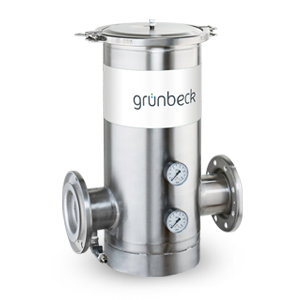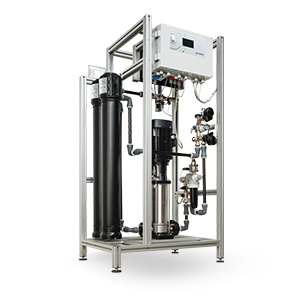Membrane Technology
Not everything gets through
The water gets through, but disruptive foreign particles do not. That is the way membranes work in water treatment. Like all membranes, they are partially permeable, and separate the filtrate (permeate) from the concentrate (retentate). The filtrate remains in the water supply system. The concentrate containing foreign substances is removed. The result: Water. Just as it should be.
Nano beats ultra beats micro
No membranes, no life. They play an important role in many biological processes. And like biological membranes, synthetic membranes and membranes used in water treatment separate desirable substances from undesirable ones. Desirable substances pass through the membrane, while the undesirable ones are retained. The separation limit determines the size at which particles are filtered out by the membrane. With a micromembrane the filtration is fine, with ultrafiltration it is finer and with nanofiltration it is even finer. Finally, there is reverse osmosis, which filters out even singly charged ions. Grünbeck offers you membrane technology with a wide variety of separation limits: the right version for every task.
Nanofiltration: Finer filtering is hardly possible
Compared to nanofiltration, ultrafilters are open doors and microfilters are open sluices. Nanofilters filter even the smallest particles out of the water: This reduces the salt content of the water, just as much as the amount of germs, pesticides, herbicides and hydrocarbons. For those who need water with extremely high purity, Grünbeck offers technology with nanofiltration. Only reverse osmosis can filter even more effectively.
An instrument against scale in water
Nanofiltration is also an instrument against too much scale in water. As a purely physical process, it can replace ion exchange, which prevents scale formation by exchanging calcium and magnesium with sodium. Nanofilters have the characteristic of separating monovalent and polyvalent ions from each other. Therefore, they can also significantly reduce the amount of calcium and magnesium in the water. Moreover, where both are missing, the basis for scale formation is also missing.
For the purest kind of pure water
Reverse osmosis produces the purest water. It filters even the smallest particles out of the water, leaving only a residual salt content of less than five percent. Otherwise, there is nothing: just water, clearer and purer than any other. Those who need the purest water therefore rely on Grünbeck membrane technology with reverse osmosis. A good choice. The best.

